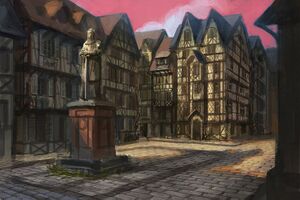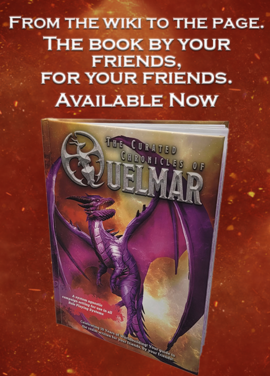Spiderjjr45 (talk | contribs) m (Text replacement - "^(?!{{Worldbuilders}})" to "{{Worldbuilders}}") |
Spiderjjr45 (talk | contribs) m (The LinkTitles extension automatically added links to existing pages (https://github.com/bovender/LinkTitles).) |
||
| Line 8: | Line 8: | ||
=== Grinding District === |
=== Grinding District === |
||
The '''Grinding District '''was the the craftsman sector, where guilds suchas the glassblowers and woodworkers were quartered. A variety of taverns that catered to the hard workers of the city resided in the Griding District. For a time, it held the only [[autom]] producing factory in Quelmar. |
The '''Grinding District '''was the the craftsman sector, where [[guilds]] suchas the glassblowers and woodworkers were quartered. A variety of taverns that catered to the hard workers of the city resided in the Griding District. For a time, it held the only [[autom]] producing factory in Quelmar. |
||
=== Temple District === |
=== Temple District === |
||
At its cosmopolitan height, the '''Temple District''' held over 20 different places of worship to a variety of gods and domains. However, between 730 and 800 [[PR]], it housed only one church: The megachurch of the [[Friends of Kragnux]]. Besides the religious temples, there was at least one non-religious hospital center in the temple district. |
At its cosmopolitan height, the '''Temple District''' held over 20 different places of worship to a variety of [[gods]] and domains. However, between 730 and 800 [[PR]], it housed only one church: The megachurch of the [[Friends of Kragnux]]. Besides the religious temples, there was at least one non-religious hospital center in the temple district. |
||
=== Market District === |
=== Market District === |
||
| Line 24: | Line 24: | ||
=== Gnomish Ghetto === |
=== Gnomish Ghetto === |
||
Not a traditional ghetto, the '''Gnomish Ghetto '''was specifically built to gnomish proportions and provided utmost quality care for any visiting or residing gnomes in Zobeck. Following in the footsteps of the [[Levinkan Dynasty|Levinkan]], many gnomes flocked to Zobeck in the belief that they too could learn to be a person of great power. Some gnomes revered the Levinkan, and others simply wanted to see if he really existed. The large populations of gnomes and gnomish traditions that moved into the city over many centuries led to this large district catering to the Gnomes. |
Not a traditional ghetto, the '''Gnomish Ghetto '''was specifically built to gnomish proportions and provided utmost quality care for any visiting or residing [[gnomes]] in Zobeck. Following in the footsteps of the [[Levinkan Dynasty|Levinkan]], many gnomes flocked to Zobeck in the belief that they too could learn to be a person of great power. Some gnomes revered the Levinkan, and others simply wanted to see if he really existed. The large populations of gnomes and gnomish traditions that moved into the city over many centuries led to this large district catering to the Gnomes. |
||
== History == |
== History == |
||
| Line 32: | Line 32: | ||
=== The Church of Kragnux === |
=== The Church of Kragnux === |
||
Over the course of several decades in the 700s [[PR]], properties in Zobeck's temple district were purchased and demolished for the ever expanding headquarters of a religion calling themselves [[The Friends of Kragnux]], who would eventually become the only religion with a sizeable church in the whole city. This reign lasted until the early 790s [[PR]] when their savior Kragnux was [[Lost God|banished]], and worship of [[Bahamut]] became fashionable again. |
Over the course of several decades in the 700s [[PR]], properties in Zobeck's temple district were purchased and demolished for the ever expanding headquarters of a religion calling themselves [[The Friends of Kragnux]], who would eventually become the only religion with a sizeable church in the whole city. This reign lasted until the early 790s [[PR]] when their savior [[Kragnux]] was [[Lost God|banished]], and worship of [[Bahamut]] became fashionable again. |
||
After the destruction of the church in the obliteration of [[Ith]], the Soul Star was abandoned in the main section of the church with all the amplifiers still attached. Over the next 5 years, it would slowly fizzle out before the dust and mist coalesced with a bright flash of light into [[Alenka]]. |
After the destruction of the church in the obliteration of [[Ith]], the [[Soul]] Star was abandoned in the main section of the church with all the amplifiers still attached. Over the next 5 years, it would slowly fizzle out before the dust and mist coalesced with a bright flash of light into [[Alenka]]. |
||
=== The [[Zobeck Art Gallery]] (ZAG) === |
=== The [[Zobeck Art Gallery]] (ZAG) === |
||
Revision as of 18:29, 17 August 2024
| Type | Large City |
|---|---|
| Government | Monarchy |
| Location | East Levinkan |
| Inhabiting Race | Gnome, Vanara, other Humanoids |
Zobeck (Established as Levincite) is the capital of the ancient Levinkan Kingdom. In the CR era, it was called Scranton, the Electric City.
About
Zobeck is broken up into 7 districts: Upper Zobeck, the Grinding District, the Temple District, the Market District, the Mercantile District, the College District, and the Gnomish Ghetto.
Upper Zobeck
Upper Zobeck was entirely dedicated to the living quarters and operating buildings of the Levinkan Dynasty, who have long reigned over Zobeck and the rest of Levinkan. Situated on a hillside that looks over the city, Upper Zobeck included the city archives, a variety of museums, a bell tower, and even its own court house that was only for Levinkan related cases.
Grinding District
The Grinding District was the the craftsman sector, where guilds suchas the glassblowers and woodworkers were quartered. A variety of taverns that catered to the hard workers of the city resided in the Griding District. For a time, it held the only autom producing factory in Quelmar.
Temple District
At its cosmopolitan height, the Temple District held over 20 different places of worship to a variety of gods and domains. However, between 730 and 800 PR, it housed only one church: The megachurch of the Friends of Kragnux. Besides the religious temples, there was at least one non-religious hospital center in the temple district.
Market District
Not to be confused with the merchant's district, the Market District was a center of free enterprise, with no guilds or unions binding any of the marketing that occurred here. The district housed a variety of open spaces to allow vendors, both locally and from abroad, to open up shop. There were few rules on what could and couldn't be sold, and the success of the market district minimized the scale and danger of Zobeck's black market.
Mercantile District
A center for more "sophisticated" merchants, the Mercantile District housed endless rows of shops, which typically doubled as housing for their shopkeepers. The various artistry guilds such as the tapestry weavers and the Zobeck leatherworkers held large centers of union politics that operated in the mercantile district. At the end of the PR era, Dipuc's Shop of Love could be found here.
College District
The College District held not just academic and bardic colleges, but also pop-up educations establishments that sought to teach whatever was 'all the rage' at the time. Examples of pop up institutions included sword swallowing schools, medicinal herb societies, and at one point even a name-reading convocation. The college district also held the largest courthouse in Zobeck.
Gnomish Ghetto
Not a traditional ghetto, the Gnomish Ghetto was specifically built to gnomish proportions and provided utmost quality care for any visiting or residing gnomes in Zobeck. Following in the footsteps of the Levinkan, many gnomes flocked to Zobeck in the belief that they too could learn to be a person of great power. Some gnomes revered the Levinkan, and others simply wanted to see if he really existed. The large populations of gnomes and gnomish traditions that moved into the city over many centuries led to this large district catering to the Gnomes.
History
At the end of the PR era, Zobeck suffered extensive structural and population losses, during its rebuilding during the CR era, the city was rechristened as Scranton.
Notable Locations
The Church of Kragnux
Over the course of several decades in the 700s PR, properties in Zobeck's temple district were purchased and demolished for the ever expanding headquarters of a religion calling themselves The Friends of Kragnux, who would eventually become the only religion with a sizeable church in the whole city. This reign lasted until the early 790s PR when their savior Kragnux was banished, and worship of Bahamut became fashionable again.
After the destruction of the church in the obliteration of Ith, the Soul Star was abandoned in the main section of the church with all the amplifiers still attached. Over the next 5 years, it would slowly fizzle out before the dust and mist coalesced with a bright flash of light into Alenka.
The Zobeck Art Gallery (ZAG)
Established at the end of the PR era in the year 1247, the ZAG was founded by Reese Lackmann, who tragically died the same day his museum was destroyed. It held The Brewtiful Bean, a café with dangerously delicious chocolate croissants, that opened in a new location after the destruction of the ZAG.
Other locations circa 1250 PR are listed in the Realmtrotter's Guide to Zobeck.
Behind the Screen
- The city of Zobeck was originally modeled after (and named for) the Kobold Press adventure setting of the same name. Over time the two have come to differ in values, history, and governing presence.


